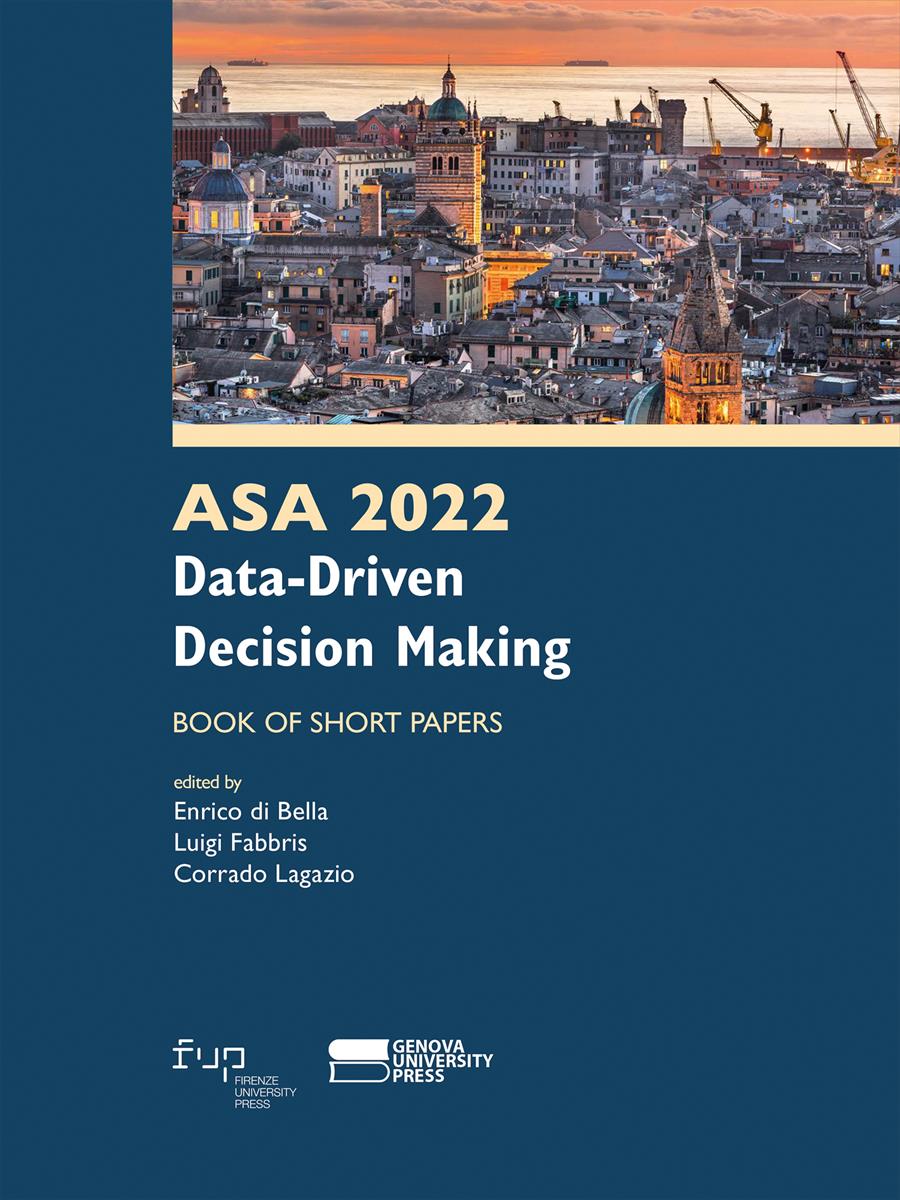- ASA 2022 Data-Driven Decision Making
- Edited by Enrico di Bella, Luigi Fabbris, Corrado Lagazio
Profiling students’ satisfaction towards university courses with a latent class approach
- G. Damiana Costanzo
- Michelangelo Misuraca
- Angela Coscarelli
- © 2023 Author(s) |
- CC BY 4.0
- DOI: 10.36253/979-12-215-0106-3.04
Collecting and analysing students’ opinions towards the learning experiences lived during their enrolment in an academic program is widely recognised as a key strategy to evaluate tertiary education quality. Academic institutions require students to participate every year in specific surveys, aiming at gathering their viewpoint about the organisation of the single courses, and the feelings about the traits and the effectiveness of the teaching activity. In the Italian university system, the surveys about students’ satisfaction are realised in accordance with the guidelines of the National Agency for the Evaluation of Universities and Research Institutes. Here we propose the implementation of a latent class analytical strategy to profile the satisfaction of students at a course level, taking into account the interest about each course, and the perceptions about the course organisation and the instructor performance. Since the items listed in the survey are expressed as 4-point balanced scales, we used the so-called Latent Profile Analysis (LPA) to identify unobserved clusters of courses (i.e., latent profiles) based on the responses of students to the continuous indicators concerning the different aspect related to course satisfaction. Differently from clustering approaches based on distance functions, LPA is a probabilistic model, which means that it models the probability of case belonging to a profile. An application of the strategy to the first-year courses delivered at the University of Calabria (Italy) in the academic year 2020/2021, during the second and third waves of the COVID-19 pandemic in Italy, is used to show the effectiveness of the approach.
- Keywords:
- latent class model,
- students' satisfaction,
- educational system evaluation,
University of Calabria, Italy - ORCID: 0000-0003-2295-3278
University of Calabria, Italy - ORCID: 0000-0002-8794-966X
University of Calabria, Italy
- Aboagye, E., Yawson, J.A., Appiah, K.N. (2021). COVID-19 and e-learning: The challenges of students in tertiary institutions. Social Education Research, 2(1), pp. 1–8
- Bergman, L.R., Magnusson, D. (1997). A person-oriented approach in research on developmental psychopathology. Development and Psychopathology, 9(2), pp. 291–319
- Biernacki, C., Celeux, G., Govaert, G. (2000). Assessing a mixture model for clustering with the integrated completed likelihood. IEEE Transactions on Pattern Analysis and Machine Intelligence, 22(7), pp. 719–725
- Chaturvedi, S., Purohit, S., Verma, M. (2021). Effective Teaching Practices for Success During COVID 19 Pandemic: Towards Phygital Learning. Frontiers in Education, 6(646557)
- Collins, L.M., Lanza, S.T. (2013). Latent class and Latent Transition Analysis: with applications in the social, behavioral, and health sciences. Wiley, New York, (NY)
- ENQA, ESU, EUA, EURASHE (2015). Standards and Guidelines for Quality Assurance in the European Higher Education Area. Brussels, Belgium
- van Buuren, S., Groothuis-Oudshoorn, K. (2011). mice: Multivariate Imputation by Chained Equations in R. Journal of statistical software, 45(3), pp. 1–67
- Fosnacht, K., McCormick, A.C., Lerma, R. (2018). First-year students’ time use in college: A latent profile analysis. Research in Higher Education, 59(7), pp. 958–978
- Hodis, F.A., Hodis, G.M. (2020). Patterns of motivation and communication in learning environments: a latent profile analysis. Social psychology of Education, 23, pp. 1659–1685
- Mai, Y., Wu, Y.J., Huang, Y. (2021). What type of social support is important for student resilience during COVID-19? A Latent Profile Analysis. Frontiers in Psychology, 12(646145)
- Nylund, K.L., Asparouhov, T., Muthén, B.O. (2007). Deciding on the number of classes in latent class analysis and growth mixture modeling: A Monte Carlo simulation study. Structural equation modeling: a multidisciplinary journal, 14(4), pp. 535–569
- Oberski, D. (2016). Mixture Models: Latent Profile and Latent Class Analysis, in Modern statistical methods for HCI, eds. J. Robertson, M. Kaptein, Springer, Cham, pp. 275–287
- Scrucca, L., Fop, M., Murphy, T.B., Raftery, A.E. (2016). mclust 5: clustering, classification and density estimation using Gaussian finite mixture models. The R Journal, 8(1), pp. 205–233
- Tein, J.-Y., Coxe, S., Cham, H. (2013). Statistical power to detect the correct number of classes in latent profile analysis. Structural equation modeling: a multidisciplinary journal, 20(4), pp. 640–657
Chapter Information
Chapter Title
Profiling students’ satisfaction towards university courses with a latent class approach
Authors
G. Damiana Costanzo, Michelangelo Misuraca, Angela Coscarelli
Language
English
DOI
10.36253/979-12-215-0106-3.04
Peer Reviewed
Publication Year
2023
Copyright Information
© 2023 Author(s)
Content License
Metadata License
Bibliographic Information
Book Title
ASA 2022 Data-Driven Decision Making
Book Subtitle
Book of short papers
Editors
Enrico di Bella, Luigi Fabbris, Corrado Lagazio
Peer Reviewed
Publication Year
2023
Copyright Information
© 2023 Author(s)
Content License
Metadata License
Publisher Name
Firenze University Press, Genova University Press
DOI
10.36253/979-12-215-0106-3
eISBN (pdf)
979-12-215-0106-3
eISBN (xml)
979-12-215-0107-0
Series Title
Proceedings e report
Series ISSN
2704-601X
Series E-ISSN
2704-5846
